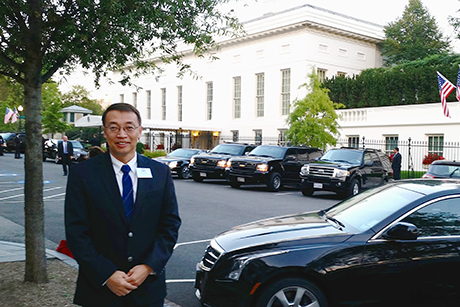Xu among scientists at White House BRAIN conference
By Anne Ju

Chris Xu, professor of applied and engineering physics, joined other academics and industry leaders at the White House Sept. 30 for a conference celebrating progress on the BRAIN (Brain Research through Advancing Innovative Neurotechnologies) Initiative, a sweeping federal effort to understand everything about the human brain.
Xu is among 58 researchers receiving a share of $46 million in National Institutes of Health funding under the $100 million BRAIN Initiative. The NIH announced this first wave of investments for BRAIN on Sept. 30.
The three-year, $1.73 million grant to Cornell will support Xu’s work in three-photon microscopy, a noninvasive, deep-tissue imaging technique that produces high-resolution, 3-D images of living tissue by harnessing the fluorescence of cells.
So far, Xu and collaborators’ three-photon microscope can penetrate a live mouse brain’s hippocampus about 1 millimeter below its surface.
Previous work had allowed them to image neurons; now they’re working on imaging neural functioning, Xu said. This optimization has involved an improved femtosecond laser, the use of longer light wavelengths to reduce tissue scattering and expression of new fluorescent protein probes. In particular, they have been using a sensor based on green fluorescent proteins – the subject of the 2008 Nobel Prize in chemistry – as targets for their microscope.
Three-photon microscopy can monitor neural activity in the mouse brain. Every time a neuron fires, an action potential opens a membrane channel that lets calcium ions rush in, and the green fluorescence activity of this function can be detected. By monitoring fluorescence intensity, the researchers can tell whether the neuron is active, Xu said.
The BRAIN Initiative has been compared to the Human Genome Project, which united thousands of scientists in the common goal of sequencing the complete human genetic blueprint.
Media Contact
Get Cornell news delivered right to your inbox.
Subscribe